Or… lots and lots of dirt roads: shaken, not stirred, is the order of the day.
But also…..what a difference 2 years makes! We are so very happy to have moved into the Tiger. We are covering some of the same country we visited up here two years back, in the Foretravel. Don’t get us wrong; we had a great trip that year. But this time we are far more relaxed; the rig is made for these roads! And we have every intention of tackling roads we wouldn’t even have given a second thought to last time around. So it’s a splendid summer and we hope it never ends!
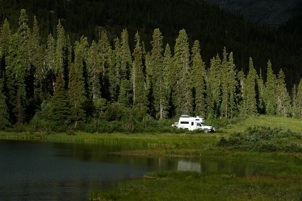
However! This part of the Alaska Highway, between say, Ft. Nelson and Whitehorse, is the loveliest section of the entire road. Leaving the flat topography of the Northwest Territories behind, we entered mountainous regions with beautiful streams, lovely vistas of far-away peaks, and greener landscapes. And critters! We spent a peaceful night tucked into a side road not far off the highway, and woke up the next morning with groups of caribou and sheep surrounding us. It was quite an experience, and we managed to get some nice pictures. Then, looking down the road a piece, Rick spotted a moose crossing the highway. Way cool!
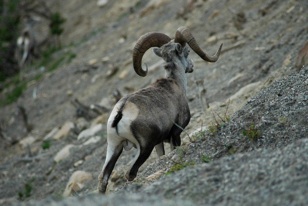
Digression aside. We traveled west as far as Watson Lake of signpost fame (if you’re familiar with this area). It seems that travelers, passing through, have taken to putting up street signs and license plates from various places; there are zillions of them in a veritable forest around the welcome centre. Very popular. We stopped there because we wanted updated information on the condition of the Campbell Highway, which we were anxious to travel on. The Campbell is a dirt road that goes north from Watson Lake, and then west to join the main road, the Klondike Highway going up to Dawson City, touching in north of Whitehorse. You won’t care, unless you’ve been there. The Campbell is well known, but not taken by too many. We had been tempted before when on our way to Alaska, but had been put off by its length – almost 400 miles – and the little experience we had had to date on non-paved roads. But we knew there were several lovely lakes along the way, and also it would give us access to the Nahanni Range Road, also dirt, and supposed to be stunningly gorgeous. With the Tiger, you can tell that our new plan was to see as much of the Yukon as was possible and passable, by whatever roads presented themselves.
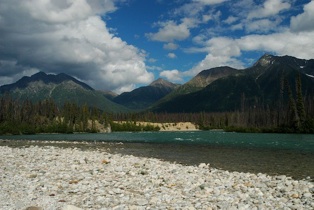
The Nahanni Range Rd is well maintained because of all the mine activity, and it was a delightful trip up a series of streams past several beautiful lakes. About 50 miles up, we found a place to camp right by a rocky stream. We spent two nights there, all by ourselves, enjoying the sounds of the river and the views of the mountains. We took down the bike to ride the rest of the way up to the top. And how filthy the poor beastie had gotten! The whole back of the coach (and bike, too, of course) was absolutely grey with accumulated dust and muck. Couldn’t hardly touch anything. But down the bike came and we washed it with water from the stream. Then off we went to explore. We cannot overstate how lovely this road is; and in good shape – a regular sedan could have made the journey up to the top. We took pictures all afternoon, and then found ourselves a long ways from the coach underneath a very threatening sky, and finally turned back about 20 miles short of the top. But a great experience, and some nice photos to show for it.
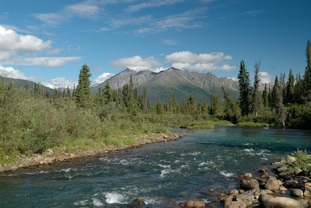
So now a word about the current cost of traveling in Canada. Things are generally more expensive here than in the states regardless of what the actual currency exchange rate is. When we spent our first summer in Canada in 2002, the exchange rate was 64 cents on the American dollar. Life was great (and relatively cheap!) as the exchange rate advantage more than negated the higher prices. The relationship between those numbers has shifted each year since, with the Canadian dollar increasing in value dramatically. This summer, our exchange rate is different now than it was just a month ago, from 93 cents on the dollar in June to very near par in July. That’s even-Steven. No more advantage at all. Damn! And groceries are very expensive, particularly as you get further north. Fresh produce…….but I’m babbling. You don’t want to hear about it. And I don’t want to talk about it! Fuel is as bad or worse, currently averaging about $4 to $4.50 a gallon for diesel and a bit more for gasoline. We console ourselves by thinking we’re preparing for eventually traveling in Europe; and are thankful that our recent vehicle changes have moved us into much improved mpg ranges on both the Tiger and the bike. As always, we try to find ways to reduce those costs by driving less and eating out less; and these days we seldom pay for camping at all so that helps too.
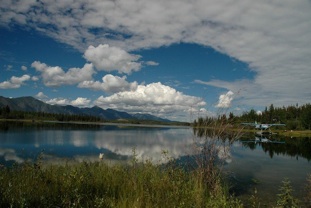
Small last digression: Try having enough food available in a refrigerator that is no bigger than a shoebox. This has been a real challenge. No buying in quantity, and it’s hard to stock up for spending several days out in the “bush.” You can’t buy a head of lettuce until you use up the last one. Extra ice cubes? I think not! But even this challenge is being met; if you could see us it would be immediately apparent that neither of us is starving to death!!!
Finally we were finished with welder, chores, and had spent all our money, and we headed north out of Whitehorse. Our route would take us up to where the Campbell joined the main road, then work our way east through Faro (stay tuned for Keno a little later on…..) and Ross River, where we would rejoin the Canol Road and could explore it going north to the border. But ya’ know, ya’ know, the South Canol Road is soooo lovely, and it was soooo rainy, let’s go down it again (at least part way) and try to see it on a sunny day.
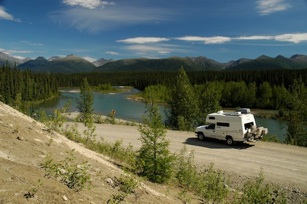
Then we had a decision to make. Go up the North Canol Road, or get to Inuvik in time to catch their Arts Festival? We had already missed two significant summer festivals, one in Yellowknife, the other in Dawson City. We knew the Inuvik event was a REALLY big deal: music, art, educational demonstrations, native drumming, all the good stuff. But the North Canol Road! Well, hell. What to do.
Inuvik won. As it was, we couldn’t possibly get there before the last weekend of the festival, but if we missed the whole shooting match we knew we would be sorry. And besides; one of our great goals for the summer was to make the trip up to Inuvik, and what were we waiting for? Soooooo. Off we went. The turnoff lay just short of Dawson City, so we stopped there for a bit, gathering supplies, doing some internet work, having a restaurant meal, and getting fuel. Then we took a deep breath, turned left onto the Dempster Highway, and started up for Inuvik.
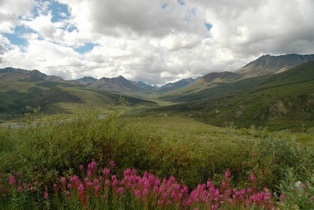
The solitude of the tundra was wonderful; it was surpassed by the beauty of the area. Sweeping plains with vistas that went on forever, mountain ranges, endless variations on the color green. We were above the upper limit of the boreal forest, and there were no trees to limit our views. It was enchanting.
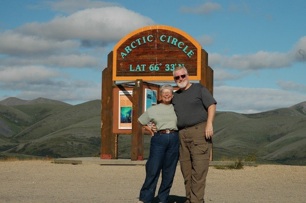
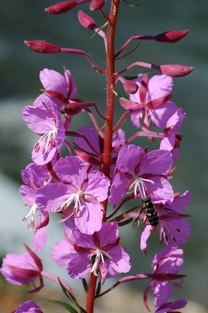
The Dempster is the lifeline for the far north of both Yukon and the towns near and including Inuvik. It is an all-year road, contains two airfields right on the roadbed, and much of it is in very good condition. Naturally, it is being worked on every summer, with sections being rebuilt as needed. Of the 450 miles, about 100 miles were a bit of a struggle; this was split between two sections, one bad because they were working on it, the other because they weren’t yet, but needed to. There is one hotel along the road, in Eagle Plains, halfway up the road. Eagle Plains has rooms, fuel and water, a restaurant and small campground, and is a firefighting base. That’s it.
One hundred and sixty miles from the top, you cross into the Northwest Territories, and the terrain begins to change. You are on the east side of the Divide now, and have entered the huge MacKenzie River basin. The MacKenzie and its tributaries drain into the Beaufort Sea, which is part of the Arctic Ocean. This is like, major north, folks. So, as you drop down from the Divide this last time, you come back into boreal forest, and start your river crossings. First the Peel, then the Arctic Red where it joins the MacKenzie; these are huge rivers, flowing fast, even in late July. (Still true in mid-August as we finish up this message) This was the second time we’d crossed the MacKenzie, having traversed it near Fort Simpson in the NWT. As before, these are ferry crossings, with all that entails: the bravado of very adept pilots. We always enjoy the experience.
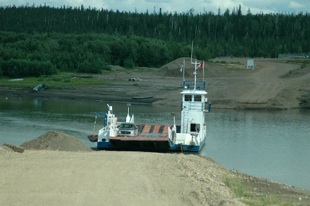
Beyond the rivers the land becomes flatter (river deltas are like that….) and less interesting. We reach sea level as we approach Inuvik. Our plan is to camp about 25 miles shy of town, take down the bike, and ride back and forth between the two for the days we are in the area. But. The rig is filthy. By conservative estimate there is a minimum of 100 lbs of mud on the back, much of it attached to the bike. Yuck! And now we are in a predicament; we cannot find water. There is so much mud that we cannot get the winch to work, etc., etc. Rick coins the term MudRed (rhymes with Blood Red) and, understandably, one half of the group refuses to ride a bike she cannot tell the color of. We are stymied in our plan; so be it. We simply take the coach back and forth. Which has advantages, of course. No big deal.
So; Inuvik: 68 degrees 21.46 minutes N. All along we had known that the big deal was the trip up, not the town at the end of the road. And no surprises. But Inuvik is a real town, with nice people, an active arts community, an excellent library, and an outstanding visitors/intrepretive centre. The centre had great examples of indigenous arts and crafts, the coolest musk ox anywhere (Rick has a thing for musk oxen…..hmmm); great explanations of permafrost, etc. We spent a long time there, and it was a real highlight of our time in Inuvik.
July 25: fell asleep at 11:20 pm with the sun still shining on my face.
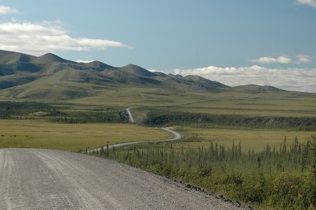
We should mention that much of the highway to Inuvik passes through traditional Gwich’in lands. There are signs asking you to treat the land with respect; that if you are caribou hunting, you must follow traditional hunting laws and treat the animals with honor, and that the first law is to aim for the heart. No sense of “keep out”; just to be good to the land.
After a nice long day in Inuvik, we turned around and came back down the hill. Not as exciting, of course, but very satisfying. We made a short stop in Fort McPherson on the Peel. Small working town, with not too much going on, except there was reportedly a very nice canvas and tent shop that was worth a visit. We enjoyed our time there. Started by the government 20 years earlier, it had in recent times been taken over by the local indigenous group, who were doing a land office business. We bought a great new case for the laptop, visited a pretty little church with cemetery, had lunch, and were on our way.
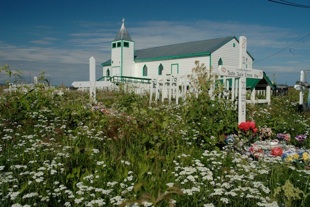
Coming down off the Dempster means one thing to most folks: a car wash. It took us almost $10 at the powerwash to make the rig at least look familiar to us; and, more importantly, the motorcycle. We had spent hours traveling behind water trucks, going through mud, and dodging around workmen. (We managed to miss the calcium carbonate truck someone had warned us about.) But we were clean enough to rejoin civilization. We had a HAMBURGER. We drove into Dawson City and got on the internet; we had FISH AND CHIPS. You get the picture!
In Dawson we drove up to the top of Midnight Dome, which we’d never done before. We stayed up there two different nights. It’s up about 3,000 feet and has a wonderful view of the town, as well as the Yukon River, which flows past. The interesting story told on the signboard at the top was about the town folk trooping up the hill on June 21, 1899 to watch the sun not set… and being disappointed when it did. They had not had the advantage of reading about what the Arctic Circle means, as we had. While pretty far north, Dawson is not above the Circle by a long shot. You must remember that this was a really interesting gold rush town; very famous. We had visited it before and have reported on all the historic things there. The town seems pretty healthy, and there is even more going on than two years ago; we hope this continues. Dawson is a fascinating place. It has a very short season (they figure 100 days between thaw and freeze-up), and makes the most of it. A worthwhile destination.
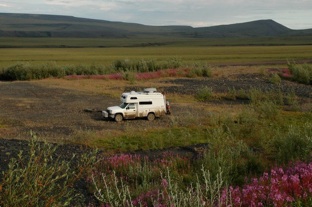
Rick, as is his wont (what the hell does that mean?), does a monthly summary of our activities. For July, we covered 4000 miles (gasp) an astounding 2,400 of them on dirt or gravel, at an average of $4.36/gallon for diesel, and $5.01 for gasoline. Gulp.
So with this depressing news at hand, do we decide to curtail our activities, not cover so many miles, try and be conservative? Hah! Of course not. We head for Alaska. Our plan is to head west from Dawson, over the Top of the World Highway (mostly dirt), through Eagle and Chicken (purportedly named by someone who couldn’t spell Ptarmigan) to Tok (like those names???) and then investigate the eastern part of the state. Our plans are very loose; we feel as though we have all the time in the world. When we are done (or Alaska is done with us…..) we’ll head back out into Yukon Territory for a few last roads as yet unexplored, then down-down-down and back into the States late in the fall.
Alaska fuel costs less than Canadian fuel, that we have been guaranteed. Our salvation?
Our best to you down there in the lower 48 as you (hopefully) enjoy your summer as much as we are ours. See you later!
Rick and Kathy
Click here to see more of our pictures of the Yukon






